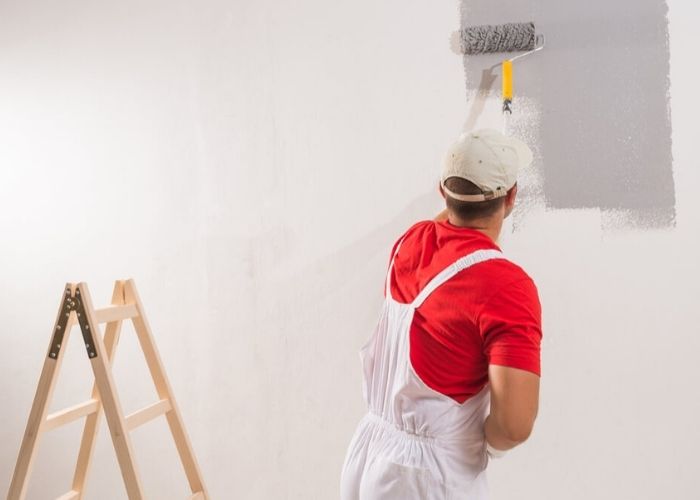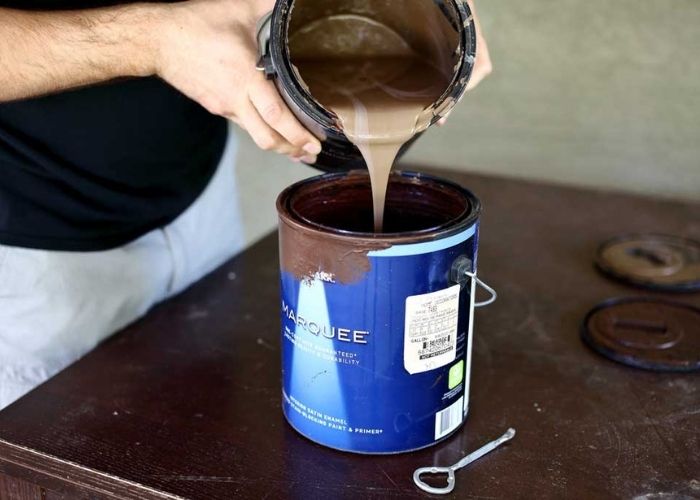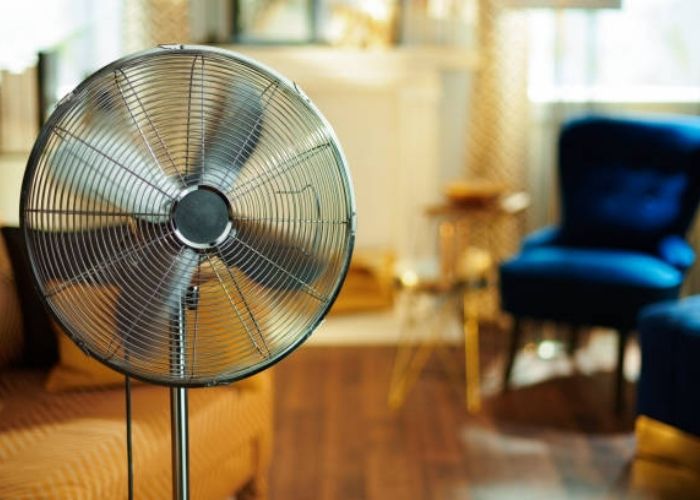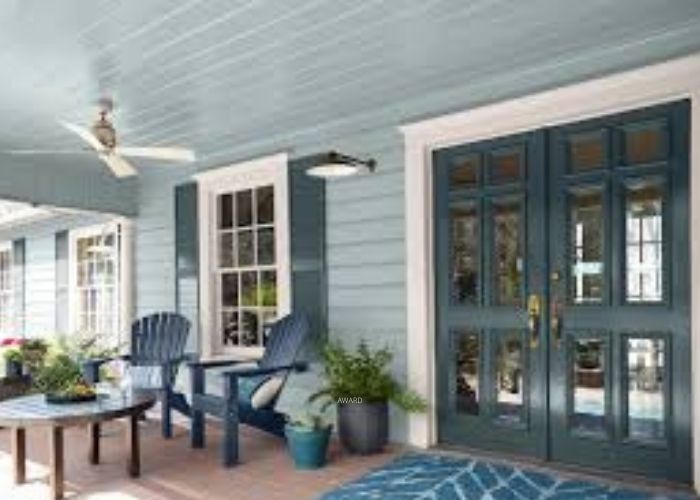You probably know that exterior paints are naturally more resilient to the elements, which may get you wondering if you could bring those benefits indoors.
Exterior-grade paints contain additives and binders that make them hold up well against harsh conditions. Using exterior paint indoors such as areas like the kitchen and bathroom, where humidity and molds are common, may sound like a good alternative.
However, this is not always common practice. So, can you use exterior paint inside? This article examines the qualities of exterior paints and why they’re not ideal for use indoors.
Can You Use Outdoor Paint Inside?
No, you should not use outdoor paint indoors. Outdoor paint contains ingredients that help protect the surface it is applied to from the elements, such as UV-resistant agents and mildew resistors. These ingredients can be toxic if used indoors, and could cause health issues for people living in the home.
Indeed this formula makes outdoor paints softer and more flexible, hence able to withstand extreme temperature changes and harsher conditions. As a result, the paint is often more durable than most interior paints.
Unfortunately, outdoor paint produces toxic fumes even after drying. Therefore, the paint will continue to off-gas VOCs until cured. Notice that while paint can dry in two to three days, it takes longer to cure.
As such, exterior paints can continue producing toxic VOCs for several weeks after using it indoors. These VOCs are generally harmful to people and pets and can make them ill.
Using exterior-grade paint indoors can expose your family to these paint fumes throughout the curing period of these paints, increasing the likelihood of suffering serious ailments.
When to Use Exterior Paint Indoors

Even though the exterior paint is not recommended for use indoors, there’re some exceptions. Here are the instances when you may use exterior-grade paint indoors safely.
Use outdoor paint inside if you are painting a storage shed or other outdoor building
The building could be a detached garage or pool cabana where nobody sleeps. Such a room is rarely occupied, so the toxic fumes from the room will be unlikely to affect your family or pets.
Since your family will not frequent the room, they will be unlikely to be exposed to the VOCs, so painting such an indoor area with exterior paint would be a great way to use any leftover paint that could go to waste.
Use outdoor paint if you will not use the room for several weeks or months
Outdoor paints take several weeks to off gas. During this time, they produce toxic fumes that can cause illness if inhaled.
If you have an outdoor building or storage room that you can keep away from for several weeks, using outdoor paint will be safe. Meanwhile, you can always open the windows to such a building to release the gases while it cures.
The paints are formulated from materials likely to be harmful in enclosed areas but are less so outdoors due to the abundance of ventilation within the exterior environment.
So opening windows will improve ventilation and allow the VOCs from these paints to escape. And staying away from the area until the paint cures or finishes off-gassing will limit your exposure to the fumes and ensure you are safe despite using the paint indoors.
Is it Dangerous to Use Exterior Paint Indoors?
Using exterior paints inside your house can expose your family to volatile organic compounds that these paints emit while curing.
Outdoor paints are loaded with additives and binders and emit toxic fumes for several weeks after drying. Exposure to these fumes can cause disease to both people and pets, so using such VOCs-emitting paints indoors can be a dangerous move.
The paints are designed for use outside because the ample ventilation outdoors helps diffuse the VOCs, rendering them harmless.
When using these paints indoors, you need to take serious precautions, which may not be practical in a family setup. These dangerous paint fumes can even last within an enclosed indoor space for as long as six months.
This could mean prolonged exposure to dangerous fumes. The home’s central heating, ventilation, and air conditioning system can also circulate the fumes from these paints, spreading out the danger.
There’s no limit to how much health damage such exposure can cause. Inhaling the fumes from these paints can cause lightheadedness or dizziness, which can be disastrous when standing on a ladder.
Therefore, applying exterior paint inside your house can be dangerous on multiple levels:
1. The VOCs from these paints can cause disease to people and pets using the painted rooms.
They can suffer headaches, nausea, lightheadedness, eye and throat irritation, respiratory complications, and other more serious concerns for persons with weak immune systems.
In addition, prolonged exposure to these VOCs could lead to cancer and other serious ailments.
2. The fumes from these paints can cause dizziness and lightheadedness to the person applying the paint.
This presents the danger of physical accidents as the person might fall off the ladder. When this happens in enclosed spaces indoors, exposure is higher, especially when applying the paint using paint sprayers.
Professional painters often wear respirators or special masks when handling exterior-grade paint to protect themselves from the fumes. This level of protection is especially essential when using a sprayer.
3. Exterior paints have strong odors. These can trigger allergic reactions in people with allergies.
Unfortunately, the odors from such paints can linger around enclosed indoor spaces for a long time. This can spell disaster for someone with related allergies as it might trigger allergic reactions.
Difference Between Exterior and Interior Paint
Most DIYers recognize exterior paint as different from interior paint, mainly based on the specifications of their respective containers. But do you know how the two paint categories differ?
Most interior paint does not contain latex
If you have used interior paint, you must have noticed that most are acrylic latex. However, the paint doesn’t often contain latex in its formula.
Most exterior paint is acrylic latex, but with the latex component added in its formula. The added resin in exterior paint makes it weather-resistant and flexible enough to withstand the extreme temperature changes outdoors.
In any case, both interior and exterior acrylic latex paint types are water-soluble when wet, with the difference between the two paint categories being more pronounced when they dry.
Due to these subtle but crucial differences, exterior acrylic latex paint is often referred to as acrylic enamel finish—specifically for the high-gloss options.
Furthermore, most acrylic enamel paint will work on exterior surfaces other than interior walls and ceilings. Other surfaces you can use the paint on include wood siding, stucco, brick, and fiber cement.
Exterior paint may take longer to cure than interior paint
Exterior-grade paint has many added ingredients, including binders and other additives that influence its cure time.
While these additives help make the product more resilient and suitable for use within harsh outdoor environments, they also delay the paint’s cure time.
As a result, outdoor paint can take several months to cure. Often, it will continue releasing toxic fumes throughout that cure time. This is one reason that makes these outdoor paints unsuitable for use indoors.
Interior paint is low in odor, unlike exterior paint
Indoors paints are low-odor because they have fewer additives and binders added. This chemical composition means they will stop emitting any noticeable smell soon after applying them on interior walls or other indoor surfaces.
Exterior-grade paint contains more additives, including UV blockers and fungicides that are toxic. They tend to have a strong odor that can cause allergies to people with smell sensitivities long after their application.
Exterior paint contains high levels of volatile organic compounds
Exterior paint generally off-gasses VOCs until it’s cured. Unfortunately, these paint types can take several weeks or months to cure in warm weather.
When used in closed indoor spaces, these volatile organic compounds can last up to six months.
In contrast, indoor pain contains a lot less harmful chemicals. Unlike exterior paints, exposure to indoor paints will often cause no noticeable side effects.
Inhaling exterior paint fumes can lead to lightheadedness, dizziness, nausea, and headaches. Professional painters wear protective masks or respirators when applying these paints, even in outdoor spaces.
Exterior and interior paint differs in terms of chemical composition
Since indoor and outdoor paint types are manufactured for different purposes, their chemical compositions and properties differ.
Exterior paint is formulated to resist fading from sun damage, chipping, cracking, water damage, and discoloration from molds and other fungi.
Interior grade paint is formulated to be easy to clean without damaging the paint layer. Therefore, these paints are easy to clean with soap and eater. Their formula is also designed to resist stains to keep indoor spaces spotless.
Overall, interior paints tend to be more friendly in their chemical composition than exterior cousins.
Can You Mix Interior and Exterior Paint?

As already mentioned, interior and exterior paint differ in chemical composition and properties. Even though they often have the same bases, they can be acrylic latex (water-based) or oil-based—mixing them is not always recommended.
Any products with the same base can be mixed. So mixing interior and exterior paint is possible as long as they are of the same base. For instance, you can mix interior oil-based paints with corresponding outdoor oil-based paints.
You should not mix indoor and outdoor paint despite that possibility because you can. Doing so might end up wasting both paints. Even if the paints are from the same manufacturer and have the same base, they are usually formulated differently.
For example, they have different binders, additives, and pigment compositions. Interior paint is formulated to resist stains and be easy to clean.
Exterior paint features a rich blend of additives to withstand the damaging sun rays, water from the rain, precipitation, high humidity, snow, and other outdoor extremes.
The many ingredients and chemicals in exterior paint make it incompatible with interior options. And if the paints mix without issues and produce usable paint, there’s still the question of where to use the resulting product.
The mixing introduces VOCs to the interior paint, making it unsuitable for use indoors. The resulting product may also be unsuitable for use outdoors after diluting it with interior paint.
It may not have the same resilience to withstand the extremes associated with outdoor environments.
So, while it may be easy to dump your leftover exterior paint into a can half-filled with interior paint and stir them to blend, the outcome may be undesirable.
What to expect from a blend of exterior and interior paints
If you paint a surface with a leftover exterior and interior paint blend, you can expect to see bubbles, flaking, peeling, or cracking.
This is because the resulting paint often has varying texture, drying time, durability, and adhesion qualities in one product.
Sometimes the colors may also change as the film of paint dries, resulting in non-uniform hues. So it’s advisable never to mix these two types of paint.
What Happens If You Use Exterior Paint Inside?
When you use exterior paints indoors, the ingredients in this paint that help prevent molds and mildew will produce fumes and odors likely to cause disease and trigger allergic reactions among people and pets.
Such paints are designed for use within open outdoor environments. When used in confined spaces with limited ventilation, they pose various health risks. Let’s break it down.
Your family may fall sick if you use exterior paint inside
These paints are high in volatile organic compounds, a health hazard. Using these paints within your living spaces will expose your family to the VOCs. This might cause them to fall sick.
If some family members are sensitive to strong odors, they may suffer allergic reactions to the strong odors coming from the paint.
People react differently to various stimuli. Therefore, severe allergic reactions can lead to more severe health complications.
Using exterior paint inside may increase the risk of premature damage
You may also lose your investment when you paint indoor spaces with exterior-grade paint.
These paints are formulated to be stretchy to withstand the extreme temperature changes outdoors. However, with that stretchiness, outdoor paints are soft compared to their indoor cousins.
Where a good quality indoor paint would resist abrasion and remain immaculate for long, an outdoor option may not have the same level of scratch resistance.
As a result, scraping against it may soon damage it and likely tear off some parts.
What to Do If You Use Exterior Paint Inside?
Although it is possible to use exterior paints indoors, you should not always do this as the paint is not recommended for indoor applications.
However, if you use the paint indoors anyway, consider taking these precautions to lessen the risks of using exterior paints indoors.
Avoid abrasive cleaning, clocks, and scuffs
Interior paint is designed to withstand scuffs, knocks, abrasive cleaning, and other similar physical impacts associated with human living.
Exterior paints are softer because they are formulated to be stretchy to withstand extreme weather changes. As a result, when used indoors, they may be vulnerable to physical impacts like scratching and abrasive cleaning.
The best way to protect such a surface is to limit any physical impact that might damage it. Start by limiting any activities that might make it dirty to necessitate abrasive cleaning, then avoid knocking or scratching it as much as possible.
Keep the area well-ventilated

VOCs from exterior paint are often harmless outdoors because of the proper ventilation outside.
However, they are the number one risk factor when these paints are used in enclosed indoor spaces. Therefore, it’s crucial to solve that ventilation problem if you paint an indoor space with exterior-grade paint.
You can keep windows open or keep fans running most of the time to dispel any VOCs within that room. If you cannot do anything about the ventilation, it is best not to use the paint first.
Only use exterior paint where you can ventilate using open windows, multiple fans, and open doors.
Protect yourself whenever within the painted room
The exterior paint will release toxic fumes for several weeks or months. Start by reading the label or asking the manufacturer about the paint’s maximum cure time.
Once you have this information, ensure you wear a respirator or special protective masks to filter the air whenever you use the painted room. Continue this ritual until the off-gassing period has elapsed.
Only after this cure period has ended can you use the room without wearing protective breathing equipment.
Pick the paint with the least VOCs if you can
Acrylic latex paint is likely to have less volatile organic compounds because of its water-based formula than oil-based options.
Unless you already have the paint at home, ask the manufacturer for the product with the lowest levels of toxic fumes before buying.
This choice will ensure that your room has fewer VOCs to deal with. It is better to find an option with the least cure time.
Keeping off a painted room for weeks is more manageable than doing so for half a year.
Read also: Best finish for interior cedar
FAQs
Can I use exterior paint in a bathroom?
Exterior paints contain fungicides and mildewcides that make them ideal for moist environments like the bathroom. However, these UV protective additives are not approved for indoor use because of their higher number of volatile organic compounds.
Using exterior paint for the bathroom can be dangerous because the paint will produce smelly fumes while off-gassing. The chemical fumes can be hazardous, especially for people with breathing problems, allergies, or chemical sensitivities.
Is it safe to use exterior paint inside?
It’s not safe to use exterior paint inside confined places. The ingredients in exterior paint that help prevent molds and mildew also cause strong-smelling fumes that can cause dizziness and lightheadedness when inhaled.
The fumes can also trigger allergic reactions used in confined spaces. These enamel or oil-based paints are likely to cure for longer than interior paint and continue off-gassing even after drying.
Can you use exterior paint on kitchen cabinets?
Exterior paints are suitable for painting kitchen cabinets and can provide great levels of moisture resistance. However, these paints are not usually recommended for painting inside of cabinets due to the confined nature of most kitchens.
The paint’s chemical makeup consists of additives and binders that emit toxic fumes likely to cause health problems when inhaled. If used on kitchen cabinets, the fumes would render the kitchen unsuitable for use until the paint cures, which can take several weeks to months.
In the unlikely event that you use exterior paint on kitchen cabinets, proper ventilation is crucial in the kitchen to ensure the safety of the kitchen’s users.
Check our guide on nuvo vs rustoleum cabinet paint to learn more about cabinet paint kits).
Can you use exterior paint on the interior walls?
Using paint designed for exterior usage on interior walls is not recommended. Exterior paints are more prone to scratches and scuffing when applied indoors despite their durability on outdoor surfaces.
That notwithstanding, the main reason for not using exterior paints inside is related to the painter’s health and the people occupying the interior space. Outdoor paints emit harmful VOCs and chemical smells that can cause neurological, respiratory, and other complications.
Can you use Sherwin-Williams exterior paint inside?
Sherwin Williams’ paints can be used on almost any surface, indoors and outdoors. This self-priming product line is low in VOCs, making it non-toxic and suitable for use inside.
Recommended reading: Valspar vs sherwin williams exterior paint.
Can you use exterior latex paint inside?
Exterior latex paint produces fumes that can irritate the eyes, throat, and nose. Using such paints indoors is not recommended as prolonged exposure to the fumes can cause dizziness, headaches, and nausea.
Can you use exterior paint on furniture?
You can use outside furniture paint without any serious problems. But using such paint on indoor furniture is not recommended. The high VOC content in most exterior paints makes them unfit and unsafe for use on indoor furniture. In addition, painting interior furniture using exterior paint can cause short- and long-term health problems for users of such furniture.
Can you use exterior acrylic latex paint inside?
While there’re no health risks associated with acrylics and water-based paints, the exterior options often contain latex with toxic UV protective additives and binders. These chemicals make outdoor acrylic latex paint unfit for indoor painting projects. In addition, like most outdoor paints, acrylic latex paints labeled for exterior use produce dangerous fumes and odors. These volatile organic compounds and strong odors make the paints harmful when used indoors.
Can you use exterior primer inside?
Yes, you can use exterior-grade primer on your indoor paint project if you have some lying around from an outdoor painting project. This can be a great way to save money, especially if the primer is water-based. Oil-based primers may contain high levels of dangerous fumes. Still, the primer can work indoors as long as you coat it with low-VOC interior paint.
Can you use exterior paint on interior trim?
Using exterior paint on interior trim is not recommended. The paint is likely to emit toxic fumes even after it has dried, which can cause illness to people and pets using the living space. In some parts of the US, using exterior paint in any indoor space, including trim, is illegal, and violations can attract heavy fines. (Here’s our recommended list of the best trim and baseboard paints).
Can you put exterior paint over interior paint?
While you can apply exterior paint over interior paint, the film may not bind well unless you use a primer before the paint. Exterior and interior paints have different chemical compositions that may cause adhesion problems. However, a suitable paint primer can always help improve adhesion and help the paint stick.
How to make interior paint into an exterior paint
You can apply interior paint outdoors by thorough surface preparation and using an exterior primer before applying the paint. The paint will not withstand temperature changes, UV, humidity, mildew, and inclement weather, as well as outdoor paints. Indoor paints lack the chemical composition to be resilient against the harsh weather conditions outside.
Final Thoughts: Can You Use Outdoor Paint Inside?
While it’s possible to paint interior spaces with an exterior product, there’re many good reasons not to do so, as learned in this article. Exterior paint releases VOCs that can be harmful to inhale even long after the surface has dried.
So it is always safer not to use exterior paint indoors. We hope this article helped answer your questions in detail. Please let us know your thoughts in the comments section.
Other related articles: Can You Use Concrete Paint or Stain on Wood?

